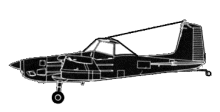
ASN Wikibase Occurrence # 331
This information is added by users of ASN. Neither ASN nor the Flight Safety Foundation are responsible for the completeness or correctness of this information.
If you feel this information is incomplete or incorrect, you can submit corrected information.
| Date: | Monday 27 November 1995 |
| Time: | 06:50 |
| Type: |  Cessna A188B/A1 |
| Owner/operator: | Private |
| Registration: | VH-HYN |
| MSN: | 188-03046T |
| Fatalities: | Fatalities: 1 / Occupants: 1 |
| Aircraft damage: | Destroyed |
| Category: | Accident |
| Location: | Home Hill, QLD -
 Australia Australia
|
| Phase: | Manoeuvring (airshow, firefighting, ag.ops.) |
| Nature: | Agricultural |
| Departure airport: | Home Hill, Queensland |
| Home Hill, Queensland | |
| Investigating agency: | BASI |
| Confidence Rating: |
The pilot had been spraying canefields near the accident site. The aircraft was observed flying towards an airstrip about 1 km away where a spray hopper was positioned on a trailer. At about 0650 hours, the aircraft was seen flying straight and level towards the airstrip. The aircraft was then seen to strike powerlines, roll inverted and impact the ground. The aircraft came to rest inverted. The aircraft had impacted two high-voltage power lines approximately 17 metres above ground level.
The fuselage forward of the wing leading edge was destroyed and the engine was forced rearwards into the hopper. The main cockpit structure was intact and the seat and harness were undamaged. The windscreen was broken but the windscreen frame was intact. The instrument panel was badly damaged by impact from the pilot. The fuselage rear of the cockpit area was creased but the tailplane and fin were intact, suffering only minor damage. The right wing outboard leading edge section was severed by powerline contact. The aircraft severed two wires. The top aerial earth wire consisted of three strands of 2.55mm aluminium conductor wound around four strands of 2.5mm steel conductor, and a 66-kilovolt cable consisted of 30 strands of 2.55mm aluminium conductor wound around seven strands of 2.5mm steel conductor.
ATSB Conclusion:
Given that the powerline was the largest and most obvious in the area, it is difficult to understand why the pilot failed to avoid it. The possibility of the low angle of the sun momentarily dazzling the pilot was considered but this is unlikely due to the aircraft being in a right turn and heading in a south-easterly direction shortly before impact.
Some witnesses described seeing what appeared to be puffs of smoke from the engine seconds before the aircraft hit the powerline. The aircraft was fitted with a smoke generator so the pilot could assess the wind drift. This could occasionally emit puffs of smoke due to small quantities of oil leaking into the system. The possibility of an engine malfunction distracting the pilot at a crucial moment and diverting his attention to inside the cockpit cannot be discounted; however, there was no evidence found to support this theory.
Accident investigation:
 |
|
Sources:
1. http://www.atsb.gov.au/publications/investigation_reports/1995/aair/aair199503986.aspx
2. http://www.atsb.gov.au/media/24930/ASOR199503986.pdf
Revision history:
| Date/time | Contributor | Updates |
|---|---|---|
| 21-Jan-2008 10:00 | ASN archive | Added |
| 04-May-2014 03:52 | Dr. John Smith | Updated [Time, Aircraft type, Operator, Total fatalities, Total occupants, Other fatalities, Location, Phase, Nature, Departure airport, Destination airport, Source, Damage, Narrative] |
| 04-May-2014 03:53 | Dr. John Smith | Updated [Aircraft type, Narrative] |
| 22-Dec-2019 10:41 | BEAVERSPOTTER | Updated [Cn] |
| 08-Jun-2022 08:42 | Ron Averes | Updated [Location] |
Corrections or additions? ... Edit this accident description
The Aviation Safety Network is an exclusive service provided by:


 ©2024 Flight Safety Foundation
©2024 Flight Safety Foundation